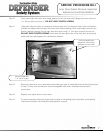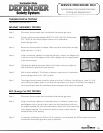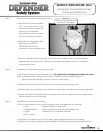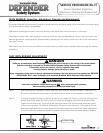
Combination Ther
mostat/Gas Valve Testing and Replacement
The combination thermostat/gas valve is a non repairable device. If trouble shooting has determined a problem with
the combination thermostat/gas valve, it must be replaced. If the burner and/or pilot do not function, service checks
for gas pressure, thermocouple output, magnet assembly and ECO are to be performed. If these check OK, the
combination thermostat/gas valve may be faulty.
LINE PRESSURE
The combination thermostat/gas valve is designed for a maximum line pressure of 14.0" w.c. and a minimum line pres-
sure of 1.0"w.c. over the water heater rated manifold pressure.
MANIFOLD PRESSURE TES
TING
(this procedure assumes a maximum line pressure of 14.0" w.c.)
Step 1. Set combination thermostat/gas valve to “OFF” position.
Step 2. Remove pressure tap plug (3/16" Allen wrench) and install pressure tap (7/16 wrench)
Step 3. Connect manometer to pressure tap.
Step 4. Follow lighting instructions and proceed to light main burner.
Step 5. Manometer gauge should read 4.0" w.c. for Natural gas and 10.0" w.c. for L.P. gas.
Step 6. If adjustment is necessary proceed to step 7. If pressure is OK, set combination thermostat/gas valve
to “OFF” remove manometer and pressure tap and replace pressure tap plug. Check for gas leaks
before placing water heater back in operation.
Step 7. While burner is in operation, remove regulator access cap to expose the regulator adjusting screw .
With small screw driver, rotate adjusting screw clockwise to increase pressure and counter clockwise to
decrease pressure.
Step 8. Set combination thermostat/gas valve to “OFF”. Remove manometer and pressure tap and replace
pressure tap plug. Check for gas leaks before placing water heater back in operation.
SERVICE PROCEDURE RG-V
Combination Thermostat/Gas Valve
Testing and Replacement
12
Pressure Tap
Shown Installed


















